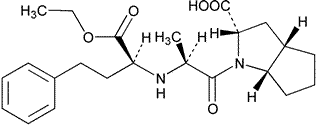Ramipril
»Ramipril contains not less than 98.0percent and not more than 101.0percent of C23H32N2O5,calculated on the dried basis.
Packaging and storage—
Preserve in tight containers.
USP Reference standards á11ñ—
USP Ramipril RS.USP Ramipril Related Compound A RS.USP Ramipril Related Compound B RS.USP Ramipril Related Compound C RS.USP Ramipril Related Compound D RS.
Identification,
Infrared Absorption á197Kñ.
Specific rotation á781Sñ:
between +32.0 and +38.0
and +38.0 ,determined at 20
,determined at 20 .
.
Test solution:
10mg per mL,in 0.1Mmethanolic hydrochloric acid.
Loss on drying á731ñ—
Dry it in vacuum at a pressure not exceeding 5mm of mercury at 60 for 6hours:it loses not more than 0.2%of its weight.
for 6hours:it loses not more than 0.2%of its weight.
Residue on ignition á281ñ:
not more than 0.1%.
Limit of palladium—
Diluent—
Prepare a mixture of water and nitric acid (997:3).
Standard stock solution—
Transfer about 50mg of palladium metal,accurately weighed,to a 100-mLvolumetric flask,dissolve in 9mLof hydrochloric acid,and dilute with water to volume.
Standard solutions—
Dilute theStandard stock solution quantitatively,and stepwise if necessary,withDiluent to obtain solutions containing 0.02,0.03,and 0.05µg of palladium per mL.
Test solution—
Transfer about 200mg of Ramipril,accurately weighed,to a 100-mLvolumetric flask,and dissolve in and dilute withDiluent to volume.
Blank solution—
Transfer about 150mg of magnesium nitrate to a 100-mLvolumetric flask,and dissolve in and dilute withDiluent to volume.
Procedure—
Concomitantly determine the absorbances of equal volumes of theStandard solutions and theTest solution (about 20µL),at the palladium emission line at 247.6nm,with a suitable atomic absorption spectrophotometer (seeSpectrophotometry and Light-Scattering á851ñ)equipped with a palladium hollow-cathode lamp,using a 10-µLinjection ofBlank solution as the blank.Plot the absorbances of theStandard solutions versus concentration,in µg per mL,of palladium,and draw the straight line best fitting the three plotted points.From the graph so obtained,determine the concentration,CP,in µg per mL,of palladium in theTest solution.Calculate the percentage of palladium in the portion of Ramipril taken by the formula:
0.1CP/CR,
in whichCRis the concentration,in mg per mL,of Ramipril taken to prepare theTest solution.The limit is 0.002%.
Related compounds—
Solution A—
Dissolve 2.0g of sodium perchlorate in a mixture of 800mLof water and 0.5mLof triethylamine,adjust with phosphoric acid to a pHof about 3.6±0.1,add 200mLof acetonitrile,and mix.
Solution B—
Dissolve 2.0g of sodium perchlorate in a mixture of 300mLof water and 0.5mLof triethylamine,adjust with phosphoric acid to a pHof about 2.6±0.1,add 700mLof acetonitrile,and mix.
Mobile phase—
Use variable filtered and degassed mixtures ofSolution AandSolution Bas directed forChromatographic system.Make adjustments if necessary (seeSystem Suitability underChromatography á621ñ).
Test solution—
Transfer about 25mg of Ramipril,accurately weighed,to a 25-mLvolumetric flask,dissolve in and dilute withSolution Ato volume,and mix.[NOTE—Keep theTest solution cold until injected.]
Resolution solution—
Dissolve a quantity of USP Ramipril RS,USP Ramipril Related Compound A RS,USP Ramipril Related Compound B RS,USP Ramipril Related Compound C RS,and USP Ramipril Related Compound D RSinSolution Bto obtain a solution with a concentration of about 0.5mg of each per mL.
Standard solution—
Dissolve an accurately weighed quantity of USP Ramipril RSinSolution B,and dilute quantitatively,and stepwise if necessary,withSolution Bto obtain a solution having a known concentration of about 0.005mg per mL.
Chromatographic system(see Chromatography á621ñ)—
The liquid chromatograph is equipped with a 210-nm detector and a 4.0-mm ×25-cm column that contains 3-µm packing L1,and is maintained at a temperature of 65 .The flow rate is about 1mLper minute.The chromatograph is programmed as follows.
.The flow rate is about 1mLper minute.The chromatograph is programmed as follows.
| Time (minutes) |
Solution A
(%) |
Solution B
(%) |
Elution |
| 0–6 | 90 | 10 | isocratic |
| 6–7 | 90®75 | 10®25 | linear gradient |
| 7–20 | 75®65 | 25®35 | linear gradient |
| 20–30 | 65®25 | 35®75 | linear gradient |
| 30–40 | 25 | 75 | isocratic |
| 40–45 | 25®90 | 75®10 | linear gradient |
| 45–55 | 90 | 10 | isocratic |
NOTE—Make adjustments at the 75:25ratio stage,if necessary,to achieve elution of ramipril between 16and 19minutes after injection of the Standard solution.
Chromatograph theResolution solution,and record the peak responses as directed forProcedure:the resolution,R,between ramipril related compound Aand ramipril is not less than 3.0.Similarly chromatograph theTest solution,and record the peak responses as directed forProcedure:the retention time for ramipril is between 16and 19minutes;and the tailing factor for the ramipril peak is between 0.8and 2.0.Chromatograph the Standard solution,and record the peak responses as directed forProcedure:the relative standard deviation for replicate injections is not more than 5.0%.[NOTE—The relative retention times are about 0.8for ramipril related compound A,1.0for ramipril,1.3for ramipril related compound B,1.5for ramipril related compound C,and 1.6for ramipril related compound D.]
Procedure—
Separately inject equal volumes (about 10µL)of the Test solutionand the Standard solution into the chromatograph,record the chromatograms,and measure the peak response for ramipril obtained from the Standard solution and the responses of all the peaks,other than the ramipril peak,obtained from the Test solution.Calculate the percentage of each related compound and unknown impurity in the portion of Ramipril taken by the formula:
100F(CS/CT)(ri/rS),
in whichFis the relative response factor for the related compound,which is 2.4for ramipril related compound C,and 1.0for all other individual impurities;CSis the concentration,in mg per mL,of USP Ramipril B RSin theStandard solution;CTis the concentration,in mg per mL,of ramipril in theTest solution;riis the peak response for each individual peak obtained from theTest solution;andrSis the ramipril peak response obtained from the Standard solution:not more than 0.5%of ramipril related compound A,ramipril related compound B,ramipril related compound C,or ramipril related compound Dis found;not more than 0.1%of any other individual impurity is found;and not more than 1.0%of total impurities is found.
Assay—
Dissolve about 300mg of Ramipril,accurately weighed,in 25mLof methanol,add 25mLof water,and titrate with 0.1Nsodium hydroxide VS,determining the endpoint potentiometrically.Perform a blank determination,and make any necessary correction (seeTitrimetry á541ñ).Each mLof 0.1Nsodium hydroxide is equivalent to 41.65mg of C23H32N2O5.
Auxiliary Information—
Staff Liaison:Andrzej Wilk,Ph.D.,Senior Scientific Associate
Expert Committee:(PA5)Pharmaceutical Analysis 5
USP28–NF23Page 1701
Pharmacopeial Forum:Volume No.28(2)Page 357
Phone Number:1-301-816-8305
